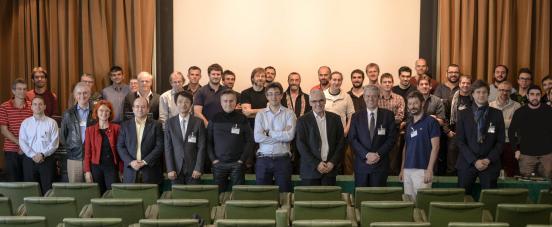Geometric and Numerical Foundations of Movements
Videos of the talks are available

The Anthropomorphic Motion Factory is a unique forum developed in the framework of the European ERC project Actanthrope (2014-2019). It is open to researchers and experts from various backgrounds, all involved in the study of human and humanoid motion. After the first workshop dedicated to « Dance Notations and Robot Motion » in 2014, the current edition is organized in collaboration with the European ERC project Taming (2015-2019) and the French ANR project Entracte (2014-2017).
Movement is a fundamental characteristic of living systems. Plants and animals must move to survive. Animals are distinguished from plants in that they have to explore the world to feed. The carnivorous plant remains at a fixed position to catch the imprudent insect. Plants must make use of self-centered motions. At the same time the cheetah goes out looking for food. Any action in the physical world requires self-centered movements, exploration movements, or a combination of both. By analogy, a manipulator robot makes use of self-centered motions, a mobile robot moves to explore the world, and a humanoid robot combines both types of motions.
While actions operate in a physical space, motions begin in a motor control space. For robots and living beings, the link between actions expressed in the physical space and motions originated in the motor space, turns to geometry in general and, in particular, to linear algebra. The idea to express robot actions as motions to be optimized has been developed in robotics since the 1970s. Geometric control theory and numerical analysis highlight two complementary perspectives on optimal human and humanoid motion. Among all possible motions performing a given action, optimization algorithms tend to choose the best motion according to a given performance criterion. Optimal motions then appear as plausible action signatures.
How to express actions in terms of motions? How to face the computational complexity of bridging the 3D physical space with the high-dimension control space? How to reveal movement synergies? How to account for the underactuation of the locomotion? What optimality criterion underlies a given action? All these questions open challenging issues to direct and inverse optimal control, with recent developments in polynomial optimization and real algebraic geometry.
The workshop “ Geometric and Numerical Foundations of Movements ” aims at gathering roboticists, control theorists, neuroscientists, and mathematicians, in order to promote a multidisciplinary research on movement analysis. Its objective is to lay the foundations for a mutual understanding that is essential for synergetic development in motion research. In particular, the workshop will provide an opportunity to promote and discuss applications to robotics --and control in general-- of new recent optimization techniques based on results from real algebraic geometry.
The workshop is by invitation only. It is organized around fifteen talks including six keynotes (A. Bicchi from IIT in Genoa, K. Friston from University College London, N. Hogan from MIT, Y. Nakamura from University of Tokyo, M. Sznaier from Northeastern University, E. Todorov from University of Washington). In order to emphasize on interactions and discussions among participants, the number of attendees is limited to 50.
Contacts: J.P. Laumond (ERC Actanthrope), J.B. Lasserre (ERC Taming), N. Mansard (ANR Entracte)
{jpl,lasserre,nmansard}@laas.fr
